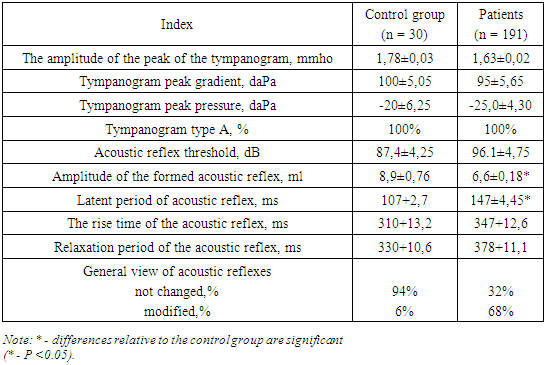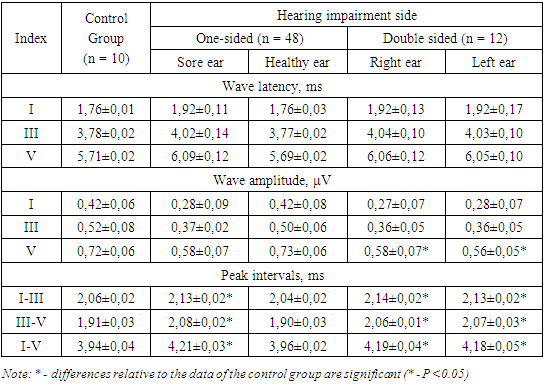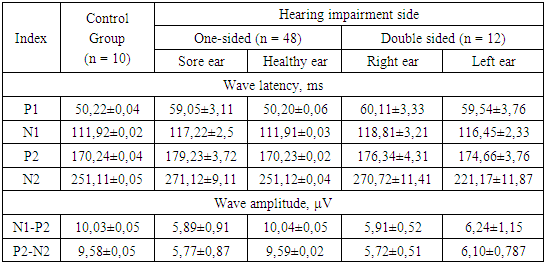-
Paper Information
- Next Paper
- Previous Paper
- Paper Submission
-
Journal Information
- About This Journal
- Editorial Board
- Current Issue
- Archive
- Author Guidelines
- Contact Us
American Journal of Medicine and Medical Sciences
p-ISSN: 2165-901X e-ISSN: 2165-9036
2021; 11(2): 140-144
doi:10.5923/j.ajmms.20211102.16
Received: Feb. 4, 2021; Accepted: Feb. 25, 2021; Published: Feb. 28, 2021

Indicators of Objective Methods of Research of Hearing in Patients with Menier's Disease During the Period Between Attacks
Arifov Sayfiddin Saidazimovich1, Tukhtaev Murod Bakidjanovich2
1Head of the Department of Center for the Development of Professional Qualifications of Medical Workers of Ministry of Health of Republic of Uzbekistan
2Researcher of the Department of Center for the Development of Professional Qualifications of Medical Workers of Ministry of Health of Republic of Uzbekistan
Copyright © 2021 The Author(s). Published by Scientific & Academic Publishing.
This work is licensed under the Creative Commons Attribution International License (CC BY).
http://creativecommons.org/licenses/by/4.0/

Purpose of the study was to analyze of the results of electrophysiological and electroacoustic methods for studying hearing in patients with Meniere's disease in the period between attacks. 191 patients with bilateral Meniere's disease aged from 31 to 67 years (main group) were examined. The control group consisted of 30 healthy individuals. The following objective research methods were used - impedance measurement, registration of delayed evoked otoacoustic emission (TEOAE), registration of the product of distortion of otoacoustic emission (PIOAE), registration of short- and long-latency auditory evoked potentials. In 89.5% of patients with BM, the absence of OAE registration was cut off, while TEOAE was not recorded in 97.4%, PIOAE - in 91.6%. In all cases, a type A tympanogram was recorded and a relationship was revealed between the registration of acoustic reflexes and the degree of hearing loss, which was manifested by a decrease in the number of frequencies at which acoustic reflexes were recorded at probed frequencies with an increase in the degree of hearing loss. ABR changes were characterized by a tendency to decrease the amplitude of all ABR peaks and lengthen their latency, and a significant change in the inter-peak intervals on the affected side. In the cortical section of the auditory analyzer, functional changes were revealed, which were manifested by an unreliable lengthening of the latency and a decrease in the amplitude of its waves (P> 0,1).
Keywords: Sensorineural, Clinical manifestation, Psychosomatic state, Otoacoustic, Interictal period
Cite this paper: Arifov Sayfiddin Saidazimovich, Tukhtaev Murod Bakidjanovich, Indicators of Objective Methods of Research of Hearing in Patients with Menier's Disease During the Period Between Attacks, American Journal of Medicine and Medical Sciences, Vol. 11 No. 2, 2021, pp. 140-144. doi: 10.5923/j.ajmms.20211102.16.
1. Introduction
- Meniere's disease (BM) is an idiopathic disease of the inner ear characterized by recurrent attacks of dizziness, the development of sensorineural hearing loss and noise in the ear (s) [3,8]. The incidence averages 13.1 new cases per 100 thousand population per year [2]. The estimated prevalence of BM varies from 17 to 513 patients per 100,000 [8].BM can occur between the ages of 17 and 80, but in most cases it occurs between the ages of 30 and 70 than in younger people. [7,11]. It in most cases occurs in the form of a unilateral lesion, although it cannot be bilateral [6].An important and most persistent clinical manifestation of BM is changes in the organ of hearing. In assessing the state of the hearing organ in BM, both psychophysiological and objective (electrophysiological and electroacoustic) research methods are used. However, due to a number of circumstances, psychophysiological research methods are most widely used among them. In particular, this is due to their availability for doctors of various levels of health care, high information content of the results. In this regard, in the sources of recent years, psychophysiological research methods are in the first positions in the list of the main research methods for patients with BM [1,8,10]. Over the past decades, objective methods of hearing research have been widely used to diagnose, predict the course and result of BM treatment [8]. Their advantage is the speed of implementation, the independence of receiving a response from the psychosomatic state of the patient, the ability to assess all parts of the organ of hearing [4]. In this regard, it is of interest to study the results of objective methods of hearing research, their features of manifestation in patients with BM.Purpose of the study. Analysis of the results of electrophysiological and electroacoustic methods for studying hearing in patients with Meniere's disease in the period between attacks.
2. Material and Research Methods
- A total of 191 patients with a reliable or confirmed diagnosis of BM were under observation, which constituted the main group. Of these, 159 patients had a reliable diagnosis in accordance with the classification of the American Academy of Otorhinolaryngology and Head and Neck Surgery, and 32 - a confirmed diagnosis, according to the classification developed jointly by the European Academy of Otology and Otoneurology, AAO - HNS, Barani Society, Japan Society for the Study of Balance, Korean society for the study of balance. These patients made up the main group. Of this number of patients, 179 (94.4%) cases were diagnosed with unilateral and 12 (5.6%) with bilateral BM. There were 127 females (66.5%), males - 64 (33.5%), their ratio was 1.5: 1. The age of the examined patients ranged from 31 to 67 years (mean age 48.8 ± 0.7 years). The duration of the disease varied widely - from 10 days to 15 years. 30 healthy individuals constituted the control group.When diagnosing BM, the tenth revision of the International Statistical Classification of Diseases and Health Problems (ICD-10) was followed. Until 2017, she additionally used the classification of criteria for the accuracy of diagnosis of Meniere's disease of the American Academy of Otorhinolaryngology and Head and Neck Surgery (AAO - HNS, 1995). Since 2018, the classification of criteria for the accuracy of diagnosis of Meniere's disease has been used by the European Academy of Otology and Otoneurology, the American Academy of Otorhinolaryngology and Head and Neck Surgery, the Barani Society, the Japan Society for Equilibrium Research, and the Korean Society for the Study of Equilibrium (2016). To assess the degree of hearing loss, the international classification of hearing impairments was used (WHO, 1997).All patients underwent examination of ENT organs and examination of the state of the organ of hearing and balance. The study of patients included the study of complaints, history of the development of the disease and life, assessment of the state of organs and body systems, endoscopic examination of the ENT organs. To assess the state of the hearing organ, the following objective research methods were used - impedance measurement, registration of delayed evoked otoacoustic emission (TEOAE), registration of the product of distortion of otoacoustic emission (PIOAE), registration of short-, long-latency auditory evoked potentials.
3. Research Results
- Comprehensive examination of patients was carried out in the period between the attacks of BM.Both classes of OAE - delayed evoked otoacoustic emission and the product of distortion of otoacoustic emission were recorded in 171 (89.5%) subjects of the control group. When registering both classes of OAE in healthy individuals, a regular correlation was revealed between age and an increase in tonal hearing thresholds by the amplitude of the otoacoustic response.The spectral indices of TEOAE in healthy individuals were characterized by:- the maximum peak of the spectrum was located at frequencies of 1300-1500 Hz;- its average amplitude, the maximum peak of the spectrum was equal to 16.2 ± 4.4 dB, which tended to decrease with increasing age.- single peaks of the spectrum were found in 31%, a wide range of responses –24% and their combination with a predominance of single peaks in 45%.- in persons over 55 years old, the minimum intensity values were recorded.In patients with BM, TEOAE was recorded only in 5 patients with first-degree hearing loss. In most cases, it was recorded with a low amplitude of the response in the form of single peaks, a decrease in the cases of their combination with each other, a narrowing of the spectrum of the curve. There was a shift in the frequency range towards lower frequencies and a decrease in the amplitude of the maximum peak with an increase in the degree of hearing impairment.PIOAE in patients with BM was recorded only in 16 patients, of whom 12 with first-degree hearing loss and 4 of the second degree were recorded. In most patients with I and II degrees of hearing loss, PIOAE. In all patients with grade III, IV hearing loss and deafness, PIOAE was not recorded. Upon registration, PIOAE also had a tendency to decrease in intensity with an increase in the degree of hearing impairment and an increase in age. Impedance measurements were carried out for all examined persons. All patients of the main group, as well as those of the control group, had a tympanogram type A.Iipsilateral acoustic reflexes were recorded at 4 probed frequencies - 500, 1000, 2000, 4000 Hz.Table 1 shows the parameters of acoustic reflexes in patients with BM.
|
|
|
4. Conclusions
- 1. In 89.5% of patients with BM, the absence of OAE registration was cut off, while TEOAE was not recorded in 97.4%, PIOAE - in 91.6%.2. Tympanogram type A was recorded in all patients and a relationship was found between the registration of acoustic reflexes and the degree of hearing loss, which was manifested by a decrease in the number of frequencies at which acoustic reflexes were recorded at probed frequencies with an increase in the degree of hearing loss.3. ABR changes were characterized by a tendency of decreasing the amplitude of all ABR peaks and lengthening their latency and a significant change in the inter-peak intervals on the affected side.4. In the cortical section of the auditory analyzer, functional changes were revealed, which were manifested by an unreliable lengthening of the latency and a decrease in the amplitude of its waves (P> 0.1).
 Abstract
Abstract Reference
Reference Full-Text PDF
Full-Text PDF Full-text HTML
Full-text HTML

